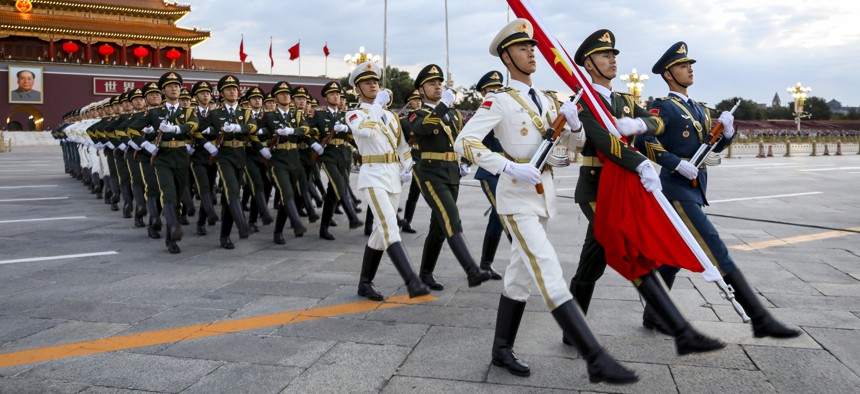
The Guard of Honor of the Chinese People's Liberation Army (PLA) escort the national flag during a flag-raising ceremony at the Tian'anmen Square to mark the 72nd anniversary of the founding of the People's Republic of China on Oct. 1, 2021 in Beijing, China. VCG / VCG via Getty Images
China’s PLA Is a Peasant Army No More
The Pentagon cannot hope to prevail merely by outspending Beijing.
In a recent interview, Chairman of the Joint Chiefs of Staff Mark Milley declared that the People’s Liberation Army had transformed “from a peasant-based infantry army that was very, very large in 1979 to a very capable military that covers all the domains and has global ambitions.” Indeed, just the last six months have seen Beijing make great leaps forward—from rapidly constructing hundreds of missile silos to successfully testing a nuclear-capable Fractional Orbital Bombardment System equipped with a hypersonic glide vehicle. Moreover, both advancements took America’s China-watchers by surprise. While comparisons to a “Sputnik moment” are hyperbolic, the harsh reality is that for nearly three decades China has undertaken a massive military buildup to offset America’s advantages—with notable success.
The shift in the balance of military power has been so dramatic that American strategists must now ask whether, in the most likely scenario of military conflict between the U.S. and China—a hot war over Taiwan—America might actually lose. When Deputy Defense Secretary Kathleen Hicks and her colleagues on the National Defense Strategy Commission examined this question in 2018, they concluded: maybe. In their words, America “might struggle to win, or perhaps lose a war against China.” Indeed, if China were to launch an attack to take control of Taiwan—an island as close to the Chinese mainland as Cuba is to the U.S.—it might succeed before the arrival of U.S. forces that could make any material difference. As former Vice Chairman of the Joint Chiefs of Staff Adm. James Winnefeld and former CIA Acting Director Michael Morell wrote last year, China has the capability to deliver a fait accompli to Taiwan before Washington would be able to decide how to respond.
Former Deputy Defense Secretary Bob Work, who served under three secretaries before retiring in 2017, has been even more explicit. As he has acknowledged, in the most realistic war games the Pentagon has been able to design simulating war over Taiwan, the score is 18 to 0. And the 18 is not Team USA.
This scorecard might shock Americans who remember the Taiwan Strait crisis of 1995-1996, when China conducted what it called “missile tests” bracketing Taiwan to deter it from a move toward independence. In response, in a show of superiority that forced Beijing to back down, the U.S. deployed two aircraft carriers to Taiwan’s adjacent waters. Today, that option is not even on the menu of responses that Chairman Milley would present to the President.
How did so much change so quickly? A new report in a series from Harvard’s China Working Group, “The Great Rivalry: China vs. the U.S. in the 21st Century,” documents what has happened in the military race between China and the U.S. in the past decades, and summarizes our best judgments about where the rivals now stand.
First, the era of U.S. military primacy is over. Defense Secretary Jim Mattis recognized China’s military rise and spoke bluntly about its consequences. His 2018 National Defense Strategy states directly: “For decades the U.S. has enjoyed uncontested or dominant superiority in every operating domain. We could generally deploy our forces when we wanted, assemble them where we wanted, and operate how we wanted.” But that was then. “Today,” Mattis warned, “every domain is contested—air, land, sea, space, and cyberspace.”
Second, in 2000, A2/AD—anti-access/area denial systems by which China could prevent U.S. military forces from operating at will—was just a PLA acronym on a briefing chart. Today, China’s A2/AD operational reach encompasses the First Island Chain, which includes Taiwan and Japan’s Ryukyu Islands. As a result, as President Obama’s Defense Undersecretary for Policy Michèle Flournoy put it, in this area, “the United States can no longer expect to quickly achieve air, space, or maritime superiority.” As Philip Davidson, then the leader of U.S. Indo-Pacific Command, testified to Congress in March, on its current trajectory, in the next four years China’s A2/AD envelope may extend to the Second Island Chain, which includes America’s principal military installations on the U.S. territory of Guam.
Finally, in Milley’s words, when “all the cards are put on the table,” the U.S. no longer dwarfs China in defense spending. In 1996, China’s reported defense budget was one-thirtieth the size of America’s. By 2020, China’s declared defense spending was one-quarter of ours. Adjusted to include spending on military research and development and other underreported items, it approached one-third of U.S. spending. And when measured by the yardstick that both CIA and the IMF judge the best single metric for comparing national economies, it is over half as much as the U.S. spends—and on a path to parity.
The reason for confronting ugly realities is not to counsel defeatism, but as a call to act now to change current trendlines. China is not 10 feet tall. But in many contests it is and will be taller than we are. Thus, unlike olden days when the Defense Department’s core strategy was essentially to overwhelm challenges with resources, success will require imaginative strategies that allow us to do more with less. That will require capitalizing on our long-term strengths, exploiting asymmetric initiatives, creating operational concepts for use, and integrating disruptive technologies. The decisions that can have the greatest positive impact are the hardest to make and execute.
Graham Allison is the Douglas Dillon Professor of Government at Harvard Kennedy School and author most recently of Destined for War: Can America and China Escape Thucydides’s Trap?
.
NEXT STORY: My Children Live in Fear of US Drones





